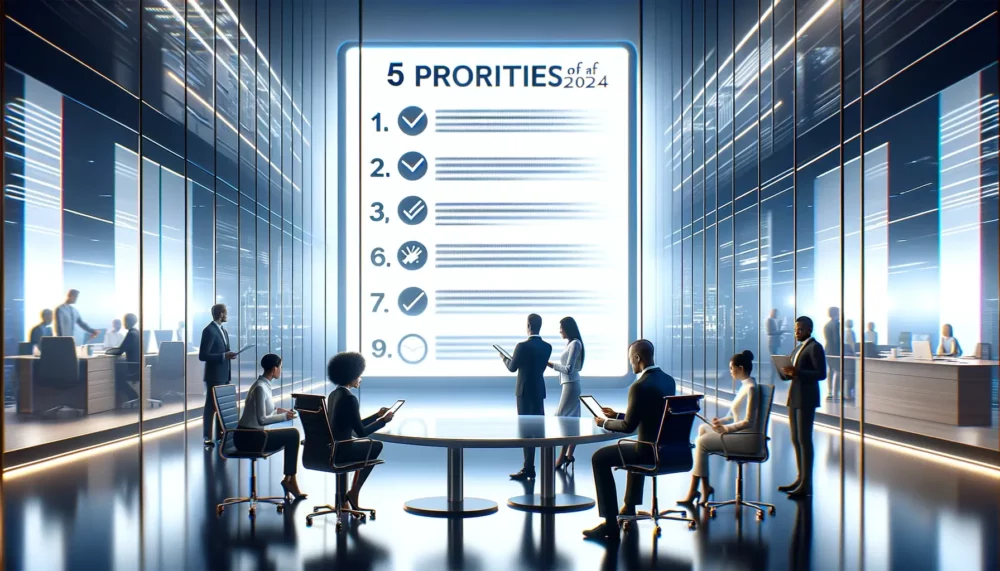5 HR Priorities for 2024 according to the World Leaders

Every year, the analytical company Gartner publishes an overview of the main trends for individual sectors including HR and people management. More than 500 top experts from all around the world identified the tasks and challenges which every HR professional should grasp in the coming year.
Surprisingly, they don’t deviate too much from what should companies in the Czech Republic deal with. So here is the overview of the main changes, which we can expect, and suggestions how to respond to them. All this in the light of key trends such as declining employee loyalty, a lack of professionals, the arrival of AI or pressure to perform.
1 – Development and modification of senior manager and team leader competencies
The issue that all executives have been dealing with for several successive years- despite their daily agenda, they’re unable to respond to new trends. They have realized that they’re missing the boat in their own development and competencies.
75% of Gartner HR leaders confirmed that managers in their companies are under pressure because of a new type of responsibility. 73% of HR professionals perceive that their leaders aren’t prepared enough to manage the changes.
It would be probably the same in the Czech Republic. If the numbers were lower, it would only be because the HR department wouldn’t be able to address the problem sufficiently.
However, the solution doesn’t arise from preparation. Managers often have more training than they’re able to handle. At the same time, half of managers think that this approach isn’t effective. Reason? The skills don’t help, for example with the fact that the average manager has about 51% more responsibilities than he is able to handle fully. Or with motivation- one out of five managers, managing his own team, would prefer not to be a manager. Then there’s “overflowing” agenda- 59% of managers struggle with “work because of work” – for example, inefficient or unnecessary reporting.
Solution?
Gartner offers four basic rescue steps that HR leader can implement.
- Reset settings and expectations: Let managers do the things they do best and don’t force them to have competencies that they naturally fail at. It’s absolutely crucial for their motivation, mental hygiene and performance as well. For example, modifying of the competency map can be useful.
- Reconfigure scope: Encourage managers to be more active co-creators of the scope they handle. For example, you can go through the biggest challenges of a managerial role with them and find out if they can handle them adequately.
- Renew routine: Work together to set up a new way of working within the team- from planning to evaluation. Of course, when these processes of managing people make sense, they will feel more confident about them.
- Eliminate process bottlenecks: Accept that there will be more work than capacity. Realistically, draw a “red line” where the area with the name “it was okay to manage it, but it’s not necessary” starts. And completely cut out ballast activities- for example, reporting that no one works with. If they’re needed in the future, they will be set up again and more efficiently.
And here is the fifth point: Stop perceiving the executives as managers and learn them towards leadership. They will realize meaningfulness of their position and their own people will notice the same. Meaningfulness of work is crucial, in terms of motivation, especially for new generations.
2- Company culture
It’s becoming clear that covid period caused damage to company culture. We begin to understand the depth of these impacts as the entire generation of employees- often the bearers of culture- changes and new colleagues enter who haven’t experienced functioning culture beyond their own team. It’s clear that due to the formation of hybrid model of work it won’t be possible to use the approved recipes of the last decade.
In fact, 41% of HR leaders mention that the hybrid mode erodes company culture or even gradually “vaporises” it. And 47% of HR leaders are unhappy about this change but they don’t know what to do about it.
Of course, the solution isn’t about sheets of paper full of empty phrases. On the contrary, the goal is to remodel culture so that it can accept the new reality and it doesn’t contradict the new reality. In conditions of the Czech companies, it will also imply significant support of mutual communication in the line of the company’s management- the last person or setting the company more in the position of “a member of the household” with empathy that results from the positioning.
What steps does Gartner suggest?
Work itself should be the main bearer of culture. The culture should be adapted in a way that it can be spread and developed by micro-teams rather than being “distributed centrally”, for example by top management. At the same time, it’s necessary to keep an eye on emotional bonds within the teams more closely and don’t allow human relationships to be depersonalised.
What steps does Sloneek suggest?
We agree that a cultivated relationship between the company and the employee is the beginning of every culture. It means that you have mastered all HR processes and you have the things in order. You enable talented people to do their job well and allow the employees to perceive where they are in relation to their employee journey. A good HRIS partner can help you to achieve it. Trust us- without these steps, every culture will actually be sliding on the surface.
When communicating, don’t forget that it’s a two- way process – dialogue, not reporting. Try to understand others and be unbiased towards younger generations.
If you care about sustainability of your business, then pay close attention to dialogues. Don’t forget that the last two generations (Y and Z) are already dominant within economically active inhabitants on Earth…
3- HR technology
A long-term sore spot of Czech companies- the slow rate of digitalization, arises mainly from the fact that managers still don’t understand the basis of it. We can at least be pleased with the fact that the situation in abroad is a little bit better but even there they don’t advance as quickly as possible. Gartner also mentions this.
According to it, 60% of HR leaders aren’t sure about how technology will change their company or department and at the same time 56% admit that technology in this context, especially HRIS and applications- that their company uses- don’t meet their real needs.
In this respect, the solution is obvious. Have your feet on the ground, be able to think in the context of real needs and be able to prioritise. Any change in the field of digitalization must be consensual and that’s just the trouble of the Czech management style. If only one part of the management forces the change, it will never work as comprehensively as it needs to be.
And this is one of the key tasks of HR leaders: To be able to propose the change and ensure a broad consensus for it. Convince (often first yourself and then the rest of the management) that what can’t be measured, can’t be managed. Especially in HR, there are a lot of digital debts.
How to start?
Analyse the company’s needs– Write down when the data or process automation would help you. The list will probably be long, so divide the individual points into groups to be more understandable.
Identify business impacts– How will the company be influenced by these changes? Which processes will be adjusted? Where will the extra agenda arise?
Describe important practical details– How much will it cost? Who will be in charge of the setup and operation of technology? What about legislative issues? Or grants?
Monitor a supplier– Who will supply us with such a solution? Don’t be afraid of sharing your needs, the right supplier should be able to speak the same language as you.
Thanks to the involvement of technology, you can finally let the machines do useless work. Some things still take time but a large part of it can be processed by technology in a playful way. Spend the time you save on a direct contact with people and the development of people or environment.
4- Management of changes
The world is changing, the economic situation is changing, the companies are changing. It has been going on for several years. People have lost a number of securities, the companies are looking for identity and instead of providing a quiet place with clear prospects, they require employees to participate in a change when the management is unable to specify the target. The implications are clear.
77% of HR leaders feel that their employees are tired. And 82% perceive that their key managers aren’t able to guide the company through the change.
What is the main reason? There have been a lot of changes. Since 2020, the rules of the game have changed several times. As a result, the planned changes quite often didn’t have time to take roots and the periods of fragile securities were followed by months when it wasn’t clear what would happen in a week. It was, in fact, a chain of really rapid transformations. It’s known that an incomplete transformation leaves behind a number of unpleasant things – process deficit, blind routines, positions without appropriate competencies and morale at its lowest ebb.
What did this mix cause according to Gartner?
- 42% of people are less inclined to stay in the company
- 17% are less involved in collective efforts
- 30% less trust the company and management
- 22% of people make less voluntary effort
- 27% of people fail to perform consistently
- 27% of people stop being “responsive”- i.e. they respond less to stimuli and don’t develop them
How to get out of this? First of all, by not considering fatigue caused by the change as part of the game. You should approach the issue on the basis of this idea. The key factor is to identify when fatigue arises quite often– it tends to be different in every company. Typically, these can be emotional “drivers”, such as lack of communication, mutual estrangement or, on the contrary, practical ones- unnecessary processes or double work. There is also the impact of inappropriate culture that is out-of-date and misapplied.
How to fix it? Above all, you have to focus on basic human needs. Maslow’s hierarchy of needs defines them. Allow people to comment on the situation and give them partial responsibility for the change. And don’t underestimate prevention- feedback or the element of personal safety.
Although it may sound like a cliché, don’t see change as a threat but as an opportunity. Technological acceleration will cause more and more changes and your company must be constantly ready. Be sure to manage the changes carefully otherwise they will manage you. 😊
5- Career management and internal career mobility
Junior- Medior- Senior. Executive- Manager- Director. Forget. As mentioned above, old securities are so broken that we have to look for new ones. It also includes career boxes.
According to Gartner, 89% of HR leaders believe that currently only few people understand career setup of their companies. Then, 66% suppose that their career setup is uninteresting and doesn’t reflect people’s real needs.
Less than one in three employees today have some idea about the career in five years. Only a quarter of them associate their career with the current company. What to do about it? First of all, it’s about changing your mindset and look at your career from different perspective. Then, reject static career paths, definition of career in terms of rigid content and organizational structure built on career bricks.
Agility is the answer. The career path should be defined mainly by competencies and their maximum fulfilment. The workload should be optimally subordinated to this. The employees aren’t rewarded for seniority and level of responsibility but for professionalism (of course, with the exception of managers). And the roles are built on the basis of experience and expertise.
Helpful hints:
- Career trajectory definition: Where am I coming from and wat is my goal from long- term perspective?
- Progress monitoring: Feedback- Am I moving forward fast or slow? What’s preventing me from fulfilling my goals?
- Essential milestones: Defining crucial milestones in the process that can help me to make further decisions.
What will be the main barrier in the Czech Republic? It’s rigidly set management. Therefore, it’ll be necessary to explore “the Czech way” which will keep the career boxes but at the same time begin to build culture of competence and skills within them. At the moment when the things move in the right direction, this approach will be strengthened at the expense of “architecture of the nineties”.
Moreover, career doesn’t just grow but primarily it monitors the fulfilment of personal ambitions. And they aren’t always associated only with the moving upwards. Simply because not everyone is born to be a leader.
Just don’t be afraid!
You might say: Nice, but I still don’t know how to do it. It’s natural. Every company is different and you probably won’t find clear instructions anywhere. The only thing we can recommend is- don’t be afraid to take the first step. Choose the one task, out of hundreds of strategic tasks, you are looking forward to the most. You’ll see that with critical thinking and a pinch of common sense, things will go smoothly. Do the same in case of the second, third, fourth and all the other tasks.
Good luck!





